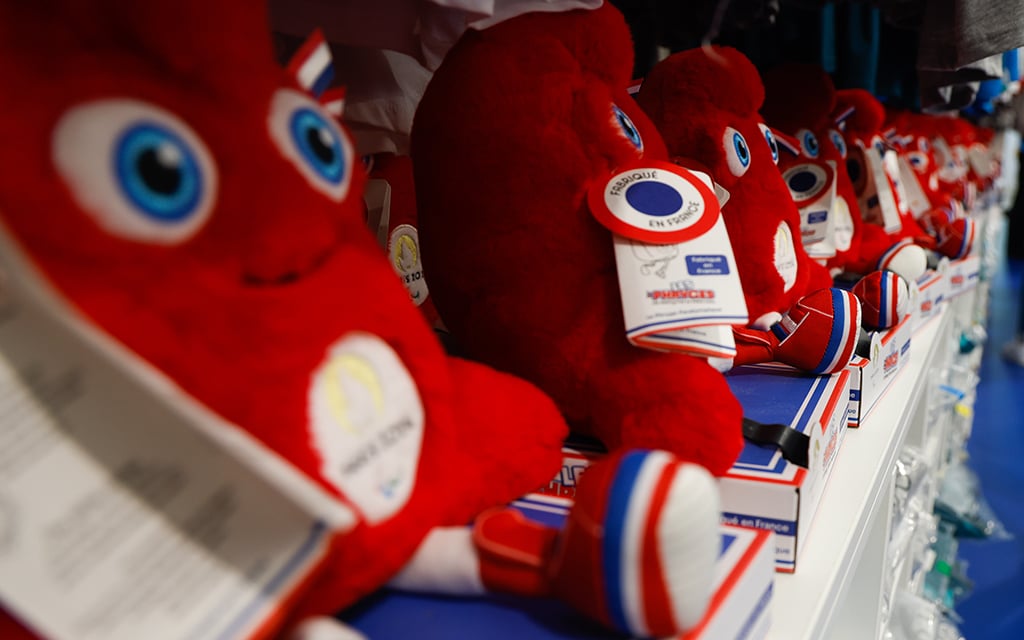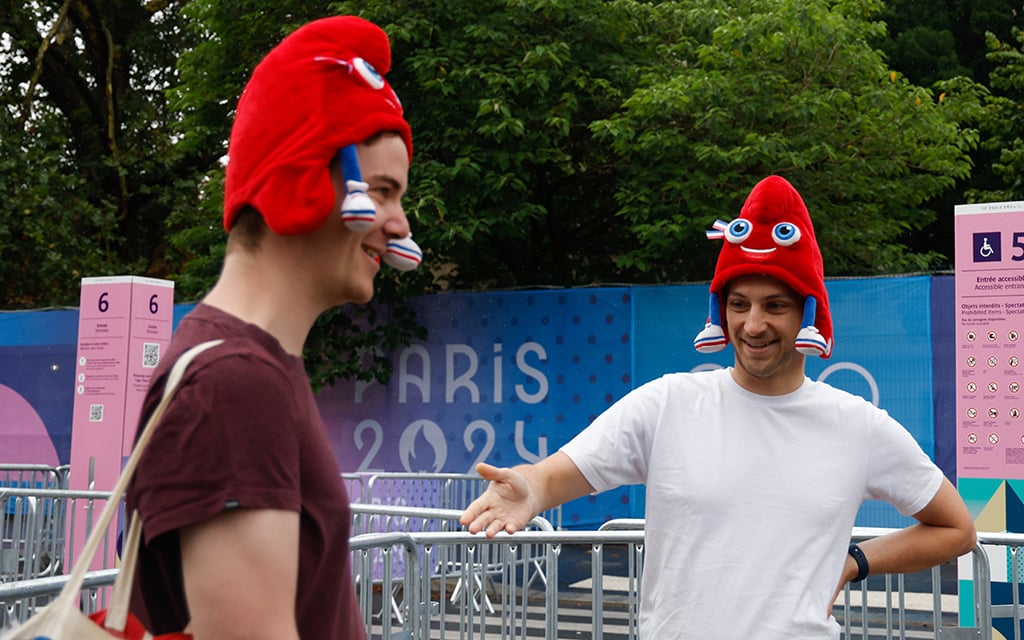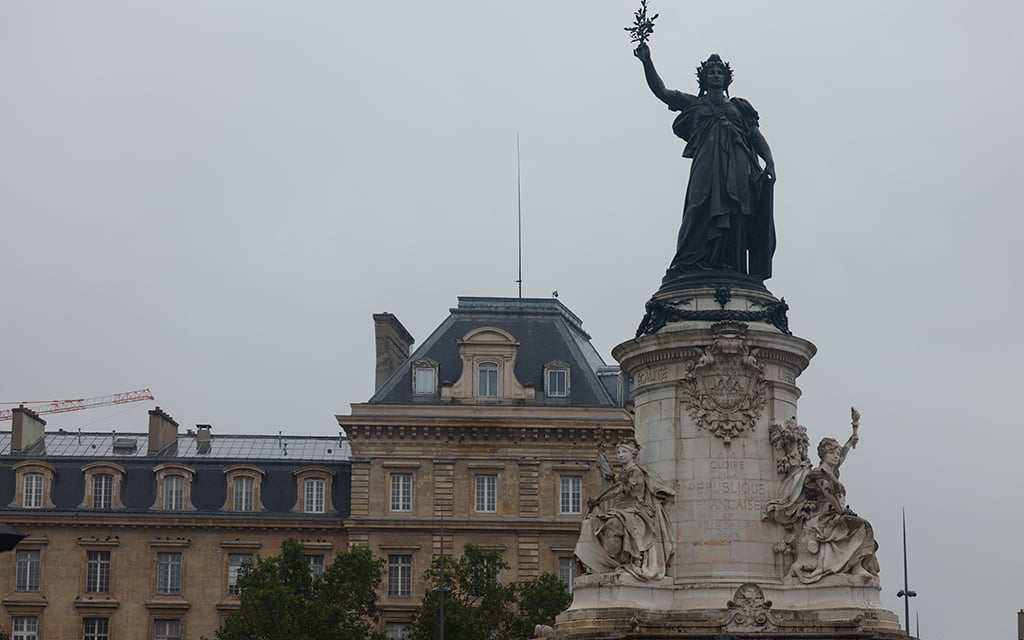
The Paralympic Phryges mascot with a running prosthetic leg is displayed for sale at the official Olympic megastore on the Champs-Élysées.(Photo by Sydney Lovan/Special for Cronkite News)

Olympic fans wear the Phryges Paris 2024 mascot hat outside of the official Olympics megastore on the Champs-Élysées. (Photo by Sydney Lovan/Special forCronkite News)
PARIS – Those walking around one of Paris’ many districts often notice a small, red stuffed animal hat with big blue eyes and eyelashes that represent France’s flag.
The Phryge is this year’s Paris Games’ mascot. It inspired the Phrygian Cap, which fans are wearing throughout Paris.
The cap is influential in French history. It’s prominently associated with the French public in 1789, during the French Revolution. The Storming of the Bastille is one of the most important events in which the cap was worn.
This Games’ mascots, the Phrygees (pronounced FREE-jes), will end up being historic, too. The one representing the Paris Paralympics showcases one of the first mascots with a physical disability. It sports a running blade to help fans identify with the sport’s movement.
“I think Paris has done an incredible job of creating a very inclusive environment, having the rings and the agitos (the Paralympics logo) displayed at the same time throughout the city so that everybody sees our logo,” paratriathlete Allysa Seely said. “Having a mascot that is able-bodied and with a visible disability, I think it’s just really cool.”
Seely, a Glendale native and Mountain Ridge High School and Arizona State alumnus, is aiming for a three-peat in the paratriathlon.
She tried her first triathlon during her freshman year at ASU and has been competing in them ever since.
“I think having them both at the Olympics and the Paralympics showing that although ‘para’ has always meant alongside, it hasn’t always seemed that way,” Seely said. “A lot of times in many games, it kind of feels like the afterthought and the big focus is on the Olympics.
“Having Paris focus on them both and display both proudly at the same time, I think it’s just absolutely incredible. I think Paris has done an incredible job.”
Tony Estanguet, president of the Paris 2024 Organizing Committee, said addressing all athletes was a priority.
“We are conscious that the majority of disabilities are not visible,” he said. “We thought that this is a strong message to have a mascot with a visible disability precisely to showcase the values of the Paralympic Games, to show our appreciation for these differences. For persons with a disability, it is a message of inclusion on the occasion of organizing the first Paralympic Summer Games in our country.”
The mascots are also a way to remind others about France’s history.
The Storming of the Bastille showcased one of the first times the people stood up to France’s tyrannical government. In the end, the revolutionaries defeated the military government, freed Bastille prisoners and earned an important win in the 10-year long battle against the French government.
Marianne – a symbol of the French Republic – can be seen wearing a Phrygian cap at the Monument à la République. Marianne is raised over 30 feet in the air, wearing a toga and raising her right fist.
The Phrygian cap is similar to previous Olympics mascots because of its significance to the host country.
Bing Dwen Dwen, a panda, was the Olympic mascot for the 2022 Games in Beijing, China. An astronaut wearing an ice suit, it was designed to send a message about new technology.

The Monument à la République representing Marianne wearing a Phrygian cap in Paris, France. (Photo by Sydney Lovan/Cronkite News
The name of the 2020 Tokyo Olympics mascot, Miraitowa, was derived from the Japanese words “mirai” (future) and “towa” (eternity), an effort to promote a world of hope. The mascot earned a majority vote by primary school students to become the mascot.
The goal of the Phrygian cap is to provide the French community with a sense of pride and patriotism.
“It’s a symbol of democracy and giving the right to the people to vote and being able to have your voice heard,” said Jonathan Broutin, a Chicago resident who grew up in Paris. “This is something of an empowerment.”
The United States and France have long been allies in major events. The French military played a prominent role in securing freedom for the United States against Great Britain in the 1770s and 1780s — another war when the revolutionaries wore the Phrygian cap.
Gilbert du Motier, Marquis de Lafayette was one of the glues between the two nations. Born in the Kingdom of France in 1757, he volunteered to join the continental army and eventually commanded the American patriots to victory at the consequential siege of Yorktown in 1781.
Lafayette wrote the Declaration of the Rights of Man and of the Citizen, which was greatly inspired by the United States’ Declaration of Independence. The author of the Declaration of Independence, Thomas Jefferson, helped Lafayette write France’s declaration.
The Phrygian cap includes red, white and blue – the three colors in both the French and American flags. It is well represented on Bastille Day, which takes place on July 14 every year. The French celebrate on public streets with military celebrations during the day, and Eiffel Tower firework shows by night.
The French will wear the red hats with a red, white and blue circle on the side. Most know the history, even the young ones.
“(The mascot) really shows the revolution of the Olympics, because it represents the hat they wore on Bastille Day, July 14,” Noah Broutin, 11, said.